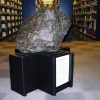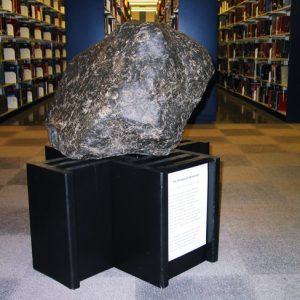calsfoundation@cals.org
Meteorites
Meteorites are fragments of rock or metal that fall from space. Except for a few that have come from the moon or Mars, meteorites represent fragments of small non-planetary bodies within the solar system, such as the objects that make up the asteroid belt. Most meteorites are remnants from the formation of the solar system that have drifted in orbits between the primary planets for over 4.5 billion years.
Meteorites are some of the most scientifically significant materials on earth. Sample return missions to find and recover these objects from their orbits in space are, in most cases, prohibitively expensive or impossible. It is extraordinarily good fortune for scientists when a new meteorite falls to earth, since each one offers an unparalleled source of information about the solar system and its history. Only fifteen meteorites have been found in the state of Arkansas. Six of these stones originated as observed falls. An additional nine meteorite “finds” resulted from un-witnessed or prehistoric falls.
Meteorite Classification
All of the meteorites found in Arkansas can be grouped into three major types: chondrites, stony-irons, and irons. The first type, chondrites, are relics of the first, relatively unsorted, unaltered materials from which the solar system formed. They provide researchers with a glimpse back in time to the earliest moments of the solar system, when the planets and sun were clumping together from a nebular cloud of dust and hot gas. They also provide insights into what one sees when looking outward into deep space. Understanding what happened in the distant past when this solar system was forming helps scientists understand what processes might be taking place in other distant star- and planet-forming environments visible in the galaxy today.
Well over ninety-nine percent of all of the matter in the solar system is contained in the sun. Since they are composed of a generalized cross section of the material from which the entire solar system was formed, chondrites are more similar in composition to the sun than to any planetary body or moon in the solar system. Chondritic meteorites have not undergone the sort of mixing, heating, and melting processes that have altered larger objects in the solar system. One could make the analogy that, if the sun and planets are like bread, the chondritic meteorites are the equivalent of samples of the uncooked dough from which they were made.
The other two types of meteorites that have been found in Arkansas, the iron and stony-iron meteorites, allow scientists to understand more of what the internal structure of the earth, moons, and asteroids in the solar system might be. The iron meteorites are almost completely composed of iron and nickel. Arkansas’s single stony-iron meteorite, which was found near Newport (Jackson County), is similar to the irons but also contains olivine crystals. The iron and stony-iron meteorites are understood to have formed from the melting and separation of metals in larger asteroids, in the same manner as the iron rich mantle and core formed within the planet earth.
Meteorite Preservation in Arkansas
Many tons of materials from space are added to the Earth each year, but most of it falls as microscopic or barely visible dust particles. What little is known about how often meteorites fall suggests that larger objects, weighing a couple of pounds or more, fall within the approximately 53,000-square-mile area of Arkansas about every year or two. Smaller objects, between about half an ounce and two pounds, fall up to fifty times more frequently than larger objects.
Meteorites are the oldest known objects on the planet. Isotopic dating has routinely shown them to be a little over 4.56 billion years old. If they fall in Arkansas, however, they do not tend to last very long. Arkansas offers an almost textbook example of the wrong conditions for preserving or finding meteorites once they reach the ground. The abundant rainfall and rich soils in the southern part of the state, and thick forest in the northern part, create an inhospitable environment for meteorites to be preserved. Since most meteorites are rich in iron and thus vulnerable to rusting, they fall apart relatively quickly under the chemical and physical onslaught of the state’s wet and biologically rich land.
Arkansas Meteorites Recovered from Witnessed Falls
| Place | Year | Type | Weight | Location |
| Cabin Creek | 1886 | Iron-Nickel (IIIAB) | 48.5 Kg | 35°30’N 93°30’W |
| Fayetteville | 1934 | H4 Chondrite | 2.36 Kg | 36°03’N 94°10’W |
| Miller | 1930 | H5 Chondrite | 16.7 Kg | 35°24’N 92°3’W |
| Norfork | 1918 | Iron-Nickel (IIIAB) | 1.05 Kg | 36°13’N 92°16’W |
| Paragould | 1930 | LL5 Chondrite | 408 Kg | 36°04’N 90°30’W |
| Success | 1924 | L6 Chondrite | 3.5 Kg | 36°29’N 90°40’W |
Arkansas Meteorite Finds
| Place | Type | Weight | Location |
| Calico Rock | Iron-Nickel (IIAB) | 7.28 Kg | 36°05’N 92°09’W |
| Delaware | L4 Chondrite | 8.35 Kg | 35°17’N 93°30’W |
| Hatfield | Iron-Nickel (IAB, Complex) | 0.021 Kg | 34°29’N 94°27’W |
| Hope | Iron-Nickel (IAB–MG) | 6.8 Kg | 33°41’N 93°36’W |
| Joe Wright Mountain | Iron-Nickel (IIIAB) | 42.6 Kg | 35°46’N 91°30’W |
| Newport | Pallasite (PMG) | 5.6 Kg | 35°36’N 91°16’W |
| Sandtown | Iron (IIIAB) | 9.35 Kg | 35°56’N 91°38’W |
| Slovak | H5 Chondrite | 8.22 Kg | 34°39’N 91°35’W |
| Western Arkansas | Iron (IVA) | 1.75 Kg | 35°N 94°W |
For additional information:
Meteoritical Society. http://www.meteoriticalsociety.org/ (accessed February 22, 2022).
Norton, O. Richard. Rocks from Space: Meteorites and Meteorite Hunters. Missoula, MT: Mountain Press Pub., 1994.
Sears, Derek W. G. Thunderstones: A Study of Meteorites Based on Falls and Finds in Arkansas. Fayetteville: University of Arkansas Press, 1988.
Robert Beauford
Eureka Springs, Arkansas
 Paragould Meteorite
Paragould Meteorite Paragould Meteorite
Paragould Meteorite 




My house got hit by a meteorite last weekend. Started a fire on the deck. I found it. Picked it up with a magnet.
I just found one, I’m pretty sure it is anyhow, in my side yard where my son plays in the dirt often. He threw it and our dog went and got it and brought it back me to throw and I thought it was just a ball of mud! And I’m pretty sure it has been there for no more than a week!
Found some meteorites in the rice fields before planting after the rain.